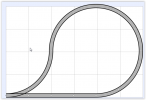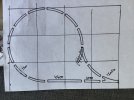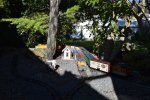Portsladepete
Registered
I am planning for next year!! I want to have a reverse loop using only R1 curves and short radius points, due to lack of space mainly. My plan is to have the point on the end of the right hand siding, with the loop either in the space between the far left siding on the grass, or alternatively in the space where you can see a broom handle (hopefully), I can’t work out how many curves I would need, or how they would match up to the point, (assume left hand).
I downloaded Anyrail, to my laptop, which decided to throw a wobbly, yesterday, so now only have iPad,so can’t use any track planning software, so am asking if any kind soul could advise.
I downloaded Anyrail, to my laptop, which decided to throw a wobbly, yesterday, so now only have iPad,so can’t use any track planning software, so am asking if any kind soul could advise.





